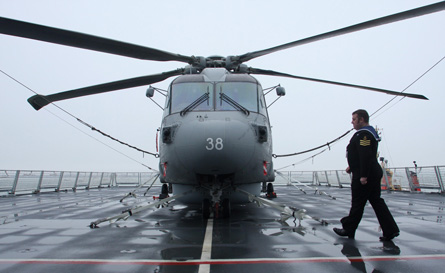The first flight of the UK Royal Navy's upgraded AgustaWestland AW101 Merlin HM2 multirole helicopter is on schedule for December 2010, with prime contractor Lockheed Martin UK Integrated Systems having received its first equipment for the aircraft.
Lockheed will shortly begin testing the first software load for the Merlin's new tactical displays at its Havant site near Portsmouth, Hampshire, with formal release expected to follow in May. The first of three Merlin HM1s to be dedicated for development and trials purposes under the Capability Sustainment Programme (CSP) has also already been stripped at AgustaWestland's Yeovil site in Somerset.
"One of the first obsolete parts in the HM1 was the displays," says Mick Fuchs, human factors engineer for Lockheed. Replacement equipment from Barco will provide the Merlin's rear crew with five times the screen display area of the current aircraft, and show new information such as overland synthetic aperture radar and inverse SAR imagery from the improved Blue Kestrel radar.
The rear mission console has also been split into two sections to make the aircraft more flexible, allowing it to carry additional troops or more stretchers.
The modernised HM2 will also get replacement cockpit displays, and a digital moving map common with the US Navy's Lockheed/AgustaWestland VH-71 presidential helicopter and Sikorsky MH-60R.
"The new human/machine interface is a major efficiency benefit," says Trevor Watkins, Lockheed's Merlin programme director. "The whole system is more intuitive, and the training burden is reduced."
Lockheed received the CSP contract in December 2005, and performed a critical design review last September. The project will modernise 30 of the RN's current Merlins (one pictured below, aboard the RN's new Type 45 destroyer, HMS Daring), enabling them to remain in service until at least 2029 by tackling obsolescence issues. However, previous options to add a further eight aircraft remain the subject of a planning review by the Ministry of Defence, Watkins says.
 |
|---|
© Ciaran McCrickard/Rex Features |
The MoD also has yet to decide whether to replace the HM1's Link 11 datalink equipment, potentially with a new multi-link system, or to fit electro-optical/infrared sensors across the fleet.
However, the removal of a planned helicopter electro-actuation technology modification released funds that have now been allocated to purchase an initial spares package for the HM2.
"We are working with the customer and user to optimise the flow of aircraft into upgrade," says Watkins. Some work will be combined with planned maintenance activities in Yeovil.
Source: Flight International




















